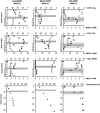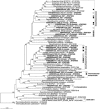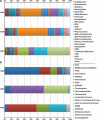Anaerobic oxidation of methane at different temperature regimes in Guaymas Basin hydrothermal sediments - PubMed (original) (raw)
Anaerobic oxidation of methane at different temperature regimes in Guaymas Basin hydrothermal sediments
Jennifer F Biddle et al. ISME J. 2012 May.
Abstract
Anaerobic oxidation of methane (AOM) was investigated in hydrothermal sediments of Guaymas Basin based on δ(13)C signatures of CH(4), dissolved inorganic carbon and porewater concentration profiles of CH(4) and sulfate. Cool, warm and hot in-situ temperature regimes (15-20 °C, 30-35 °C and 70-95 °C) were selected from hydrothermal locations in Guaymas Basin to compare AOM geochemistry and 16S ribosomal RNA (rRNA), mcrA and dsrAB genes of the microbial communities. 16S rRNA gene clone libraries from the cool and hot AOM cores yielded similar archaeal types such as Miscellaneous Crenarchaeotal Group, Thermoproteales and anaerobic methane-oxidizing archaea (ANME)-1; some of the ANME-1 archaea formed a separate 16S rRNA lineage that at present seems to be limited to Guaymas Basin. Congruent results were obtained by mcrA gene analysis. The warm AOM core, chemically distinct by lower porewater sulfide concentrations, hosted a different archaeal community dominated by the two deep subsurface archaeal lineages Marine Benthic Group D and Marine Benthic Group B, and by members of the Methanosarcinales including ANME-2 archaea. This distinct composition of the methane-cycling archaeal community in the warm AOM core was confirmed by mcrA gene analysis. Functional genes of sulfate-reducing bacteria and archaea, dsrAB, showed more overlap between all cores, regardless of the core temperature. 16S rRNA gene clone libraries with Euryarchaeota-specific primers detected members of the Archaeoglobus clade in the cool and hot cores. A V6-tag high-throughput sequencing survey generally supported the clone library results while providing high-resolution detail on archaeal and bacterial community structure. These results indicate that AOM and the responsible archaeal communities persist over a wide temperature range.
Figures
Figure 1
Compilation of geochemical profiles for Guaymas Basin sediment cores with cool, warm and hot temperature regimes. From top to bottom, the rows show methane porewater concentrations (black squares) and δ13C profiles (white circles); DIC porewater concentrations (black squares) and δ13C profiles (white circles); sulfide (black squares) and sulfate (white circles) porewater concentration profiles; and in-situ temperature profiles determined with the Alvin heatflow probe. The grey-shaded sediment layers were used for DNA and RNA extraction, and cloning and sequencing from adjacent molecular biology cores; they correspond to temperature regimes of 15–20 °C at the cool Mat Mound cores, 30–35 °C at the warm Megamat cores and 60–95 °C at the hot UNC mat cores. The additional lighter-shaded sediment layers in the hot core (8 to 10 cm and 12 to 14 cm depth) were used for amplification of mcrA genes, in addition to mcrA genes from 10 to 12 cm depth.
Figure 2
Archaeal 16S rRNA gene phylogeny of Guaymas Basin clones from hydrothermal sediment cores at 15–20 °C (open squares), 30–35 °C (grey squares) and 60–95 °C (black squares). Clones previously found at Guaymas Basin are included for context. rRNA clones are marked RNA in boldface, after the core number 4489. This neighbor-joining tree was constructed in ARB using 16S rRNA gene positions 28 to 915. Shorter clone sequences (marked EURY) were added subsequently without altering the tree topology. Bootstrap values over 50% based on 1000 replicates are shown.
Figure 3
Neighbor-joining distance phylogeny of mcrA genes from Guaymas Basin hydrothermal sediment cores at 15–20 °C (open squares), 30–35 °C (grey squares) and 60–95 °C (black squares). Clones previously found at Guaymas Basin are included for context. Bootstrap values over 50% based on 1000 replicates are shown.
Figure 4
Neighbor-joining distance phylogeny of predicted amino acid translations of partial dsrAB genes from Guaymas Basin hydrothermal sediment cores at 15–20 °C (open squares), 30–35 °C (grey squares) and 60–95 °C (black squares). Clones previously found at Guaymas Basin are included for context. Bootstrap values over 50% based on 1000 replicates are shown.
Figure 5
Bar charts of V6 tagged sequencing for (a) bacterial and (b) archaeal primer sets, for the hot, warm and cool sediment samples (cores 4489,10–12 cm; core 4486-22, 6–8 cm; and core 4483-21, 8–10 cm, respectively). The 100% bar corresponds to (a) 55 000 bacterial and (b) 31 000 archaeal sequences. Bacterial taxa represented by fewer than 300 V6-tag sequences are pooled as ‘other' these include the Caldiserica, Chlamydiae, Chlorobi, Cyanobacteria, Elusimicrobia, Fibrobacteres, Fusobacteria, Gemmatimonadetes, Epsilonproteobacteria, Tenericutes, Thermotogae, Verrucomicrobia, and the Candidate subdivisions OP1, OP10, OP11, OP2, OP3, TG-1 and WS-1.
Similar articles
- Microbial diversity of hydrothermal sediments in the Guaymas Basin: evidence for anaerobic methanotrophic communities.
Teske A, Hinrichs KU, Edgcomb V, de Vera Gomez A, Kysela D, Sylva SP, Sogin ML, Jannasch HW. Teske A, et al. Appl Environ Microbiol. 2002 Apr;68(4):1994-2007. doi: 10.1128/AEM.68.4.1994-2007.2002. Appl Environ Microbiol. 2002. PMID: 11916723 Free PMC article. - An anaerobic methane-oxidizing community of ANME-1b archaea in hypersaline Gulf of Mexico sediments.
Lloyd KG, Lapham L, Teske A. Lloyd KG, et al. Appl Environ Microbiol. 2006 Nov;72(11):7218-30. doi: 10.1128/AEM.00886-06. Epub 2006 Sep 15. Appl Environ Microbiol. 2006. PMID: 16980428 Free PMC article. - On the relationship between methane production and oxidation by anaerobic methanotrophic communities from cold seeps of the Gulf of Mexico.
Orcutt B, Samarkin V, Boetius A, Joye S. Orcutt B, et al. Environ Microbiol. 2008 May;10(5):1108-17. doi: 10.1111/j.1462-2920.2007.01526.x. Epub 2008 Jan 23. Environ Microbiol. 2008. PMID: 18218032 - Physiology and Distribution of Archaeal Methanotrophs That Couple Anaerobic Oxidation of Methane with Sulfate Reduction.
Bhattarai S, Cassarini C, Lens PNL. Bhattarai S, et al. Microbiol Mol Biol Rev. 2019 Jul 31;83(3):e00074-18. doi: 10.1128/MMBR.00074-18. Print 2019 Aug 21. Microbiol Mol Biol Rev. 2019. PMID: 31366606 Free PMC article. Review. - Genomic Insights into Niche Partitioning across Sediment Depth among Anaerobic Methane-Oxidizing Archaea in Global Methane Seeps.
Chen J, Li Y, Zhong C, Xu Z, Lu G, Jing H, Liu H. Chen J, et al. mSystems. 2023 Apr 27;8(2):e0117922. doi: 10.1128/msystems.01179-22. Epub 2023 Mar 16. mSystems. 2023. PMID: 36927099 Free PMC article. Review.
Cited by
- Deep-branching ANME-1c archaea grow at the upper temperature limit of anaerobic oxidation of methane.
Benito Merino D, Zehnle H, Teske A, Wegener G. Benito Merino D, et al. Front Microbiol. 2022 Sep 23;13:988871. doi: 10.3389/fmicb.2022.988871. eCollection 2022. Front Microbiol. 2022. PMID: 36212815 Free PMC article. - Degradation of biological macromolecules supports uncultured microbial populations in Guaymas Basin hydrothermal sediments.
Pérez Castro S, Borton MA, Regan K, Hrabe de Angelis I, Wrighton KC, Teske AP, Strous M, Ruff SE. Pérez Castro S, et al. ISME J. 2021 Dec;15(12):3480-3497. doi: 10.1038/s41396-021-01026-5. Epub 2021 Jun 10. ISME J. 2021. PMID: 34112968 Free PMC article. - Characteristics of the cultivable bacteria from sediments associated with two deep-sea hydrothermal vents in Okinawa Trough.
Sun QL, Wang MQ, Sun L. Sun QL, et al. World J Microbiol Biotechnol. 2015 Dec;31(12):2025-37. doi: 10.1007/s11274-015-1953-8. Epub 2015 Sep 26. World J Microbiol Biotechnol. 2015. PMID: 26410427 - Genomic insights into potential interdependencies in microbial hydrocarbon and nutrient cycling in hydrothermal sediments.
Dombrowski N, Seitz KW, Teske AP, Baker BJ. Dombrowski N, et al. Microbiome. 2017 Aug 23;5(1):106. doi: 10.1186/s40168-017-0322-2. Microbiome. 2017. PMID: 28835260 Free PMC article. - A PCR-Based Survey of Methane-Cycling Archaea in Methane-Soaked Subsurface Sediments of Guaymas Basin, Gulf of California.
Hinkle JE, Mara P, Beaudoin DJ, Edgcomb VP, Teske AP. Hinkle JE, et al. Microorganisms. 2023 Dec 10;11(12):2956. doi: 10.3390/microorganisms11122956. Microorganisms. 2023. PMID: 38138100 Free PMC article.
References
- Albert DB, Martens CS. Determination of low-molecular weight organic acid concentrations in seawater and pore-water samples via HPLC. Mar Chem. 1997;56:27–37.
- Bowles MW, Samarkin VA, Bowles KM, Joye SB. Weak coupling between sulfate reduction and the anaerobic oxidation of methane in methane-rich seafloor sediments during ex situ incubation. Geochim Cosmochim Acta. 2011;75:500–519.
- Cline JD. Spectrophotometric determination of hydrogen sulfide in natural waters. Limnol Oceanog. 1969;14:454–458.
Publication types
MeSH terms
Substances
LinkOut - more resources
Full Text Sources
Molecular Biology Databases




